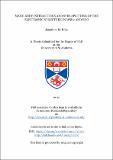Files in this item
Many-Body Interactions and Spin-Splitting of the Electronic Structure in WSe2 and EuO
Item metadata
| dc.contributor.advisor | King, Phil | |
| dc.contributor.advisor | Hoesch, Moritz | |
| dc.contributor.advisor | Hesjedal, T. | |
| dc.contributor.author | Riley, Jonathon M. | |
| dc.coverage.spatial | 193 p. | en_US |
| dc.date.accessioned | 2018-07-25T15:20:14Z | |
| dc.date.available | 2018-07-25T15:20:14Z | |
| dc.date.issued | 2017 | |
| dc.identifier.uri | https://hdl.handle.net/10023/15707 | |
| dc.description.abstract | The ability to create and control spin-polarised electronic states in solids is vital for realising all-electrical manipulation of spins for the next generation of electronic devices. Such devices are likely to rely upon the injection of a spin-current into a semiconducting material whereupon the current is manipulated for the transfer of data. Two such materials that have been proposed for spin injection and manipulation are EuO, a ferromagnetic semiconductor, and WSe2, a member of the layered transition metal dichalcogenides, respectively. By directly probing the electronic band structure using angle-resolved photoemission spectroscopy, ARPES, and its spin-resolved analogue, SARPES, a "hidden" spin-polarisaion is observed in bulk WSe2 due to the local breaking of inversion symmetry that locks the spin to the valley- and layer-pseudospins. By chemical gating, the layerdegeneracy is broken which induces a spin-splitting of the valence bands and the formation of a 2DEG. Increasing the carrier density of the 2DEG is shown to result in a lowering of the chemical potential, providing direct spectroscopic evidence for many body effects due to electron-electron interactions. Whereas WSe2 hosts spin-polarised states due to local inversion-symmetry breaking, ferromagnetism induces spin-polarised valence and conduction band states in Gd-doped EuO that break time-reversal symmetry. Using ARPES, the full 3D dispersion of the conduction bands is observed for the first time and the temperature dependence of the spin-split conduction band is analysed. By varying the Gd concentration, the carrier density is varied, revealing two kinds of satellite features due to electron-phonon and electron-plasmon interactions in the low temperature phase. Thus, despite differences in dimensionality, structure and symmetries, both materials show evidence of electron interactions which are directly measurable by ARPES and are seen to host spin-split electronic states that can be manipulated via external conditions. | en |
| dc.language.iso | en | en_US |
| dc.publisher | University of St Andrews | |
| dc.subject.lcc | TK7874.R5 | |
| dc.title | Many-Body Interactions and Spin-Splitting of the Electronic Structure in WSe2 and EuO | en_US |
| dc.type | Thesis | en_US |
| dc.type.qualificationlevel | Doctoral | en_US |
| dc.type.qualificationname | PhD Doctor of Philosophy | en_US |
| dc.publisher.institution | The University of St Andrews | en_US |
| dc.identifier.doi | https://doi.org/10.17630/10023-15707 |
This item appears in the following Collection(s)
Items in the St Andrews Research Repository are protected by copyright, with all rights reserved, unless otherwise indicated.

